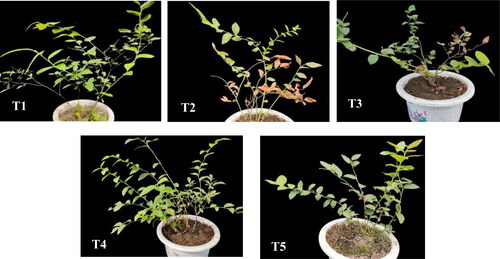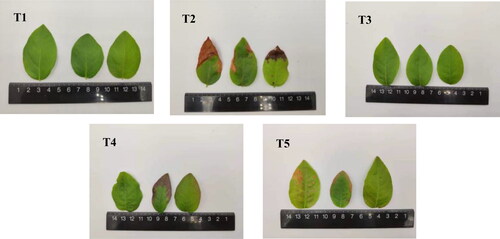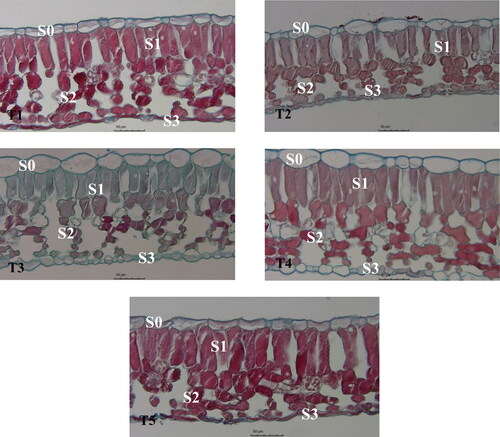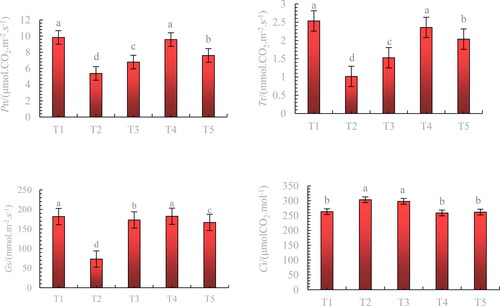Figures & data
Figure 1. Effect of exogenous application of melatonin on the growth of blueberry seedlings at day 30 after mixed salt stress.
Note: The figure shows the growth of blueberry at the 30th day of treatments. Control T1: nonstressed plants, watered with 1/10 modified Hoagland nutrient solution; Control T2: watered with saline (90 mmol·L−1 mixed salt + 1/10 modified Hoagland nutrient solution); T3, T4, and T5: watered with sprays of 100, 200, and 300 μmol·L−1 melatonin solution and saline (90 mmol·L−1 mixed salt + 1/10 modified Hoagland nutrient solution), respectively.

Figure 2. Effect of exogenous application of melatonin on blueberry leaves at day 30 after mixed salt stress.
Note: Control T1: nonstressed plants, watered with 1/10 modified Hoagland nutrient solution; Control T2: watered with saline (90 mmol·L−1 mixed salt + 1/10 modified Hoagland nutrient solution); T3, T4, and T5: watered with sprays of 100, 200, and 300 μmol·L−1 melatonin solution and saline (90 mmol·L−1 mixed salt + 1/10 modified Hoagland nutrient solution), respectively.

Table 1. Effects of exogenous application of melatonin on blueberry growth indicators under mixed salt stress.
Figure 3. Effects of exogenous application of melatonin on the anatomical structure of blueberry leaves under mixed salt stress.
Note: Blueberry leaf cross-sections at 400× magnification are shown; scale bars =1:50 μm. Control T1: nonstressed plants, watered with 1/10 modified Hoagland nutrient solution. Control T2: watered with saline (90 mmol·L−1 mixed salt + 1/10 modified Hoagland nutrient solution); T3, T4, and T5: watered with sprays of 100, 200, and 300 μmol·L−1 melatonin solution and saline (90 mmol·L−1 mixed salt + 1/10 modified Hoagland nutrient solution), respectively. S0: upper epidermis; S1: palysade parenchyma; S2: spongy parenchyma; S3: lower epidermis.

Table 2. Effects of exogenous application of melatonin on the anatomical structure of blueberry leaves under mixed salt stress.
Figure 4. Effect of exogenous application of melatonin on the physiological characteristics of blueberry under mixed salt stress.
Note: Control T1: nonstressed plants, watered with 1/10 modified Hoagland nutrient solution. Control T2: watered with saline (90 mmol·L − 1 mixed salt + 1/10 modified Hoagland nutrient solution); T3, T4, and T5: watered with sprays of 100, 200, and 300 μmol·L − 1 melatonin solution and saline (90 mmol·L − 1 mixed salt + 1/10 modified Hoagland nutrient solution), respectively. Data represent the mean ± SD of three trials for each treatment. Different letters within each panel indicate significant differences (p < 0.05).

Figure 5. Effects of exogenous application of melatonin on the photosynthetic properties of blueberry leaves under mixed salt stress.
Note: Control T1: nonstressed plants, watered with 1/10 modified Hoagland nutrient solution. Control T2: watered with saline (90 mmol·L − 1 mixed salt + 1/10 modified Hoagland nutrient solution); T3, T4, and T5: watered with sprays of 100, 200, and 300 μmol·L − 1 melatonin solution and saline (90 mmol·L − 1 mixed salt + 1/10 modified Hoagland nutrient solution), respectively. Data represent the mean ± SD of three trials for eachv treatment. Different letters within each panel indicate significant differences (p < 0.05).

Figure 6. Effect of exogenous application of melatonin on the chlorophyll content of blueberry leaves under mixed salt stress.
Note: Control T1: nonstressed plants, watered with 1/10 modified Hoagland nutrient solution. Control T2: watered with saline (90 mmol·L − 1 mixed salt + 1/10 modified Hoagland nutrient solution); T3, T4, and T5: watered with sprays of 100, 200, and 300 μmol·L − 1 melatonin solution and saline (90 mmol·L − 1 mixed salt + 1/10 modified Hoagland nutrient solution), respectively. Data represent the mean ± SD of three trials for each treatment. Different letters within each panel indicate significant differences (p < 0.05).

Table 3. Effect of exogenous application of melatonin on the Na+ and K+ contents of blueberry roots, stems, and leaves under mixed salt stress.
Data availability statement
All data included in this study are available upon request by contact with the corresponding authors.
